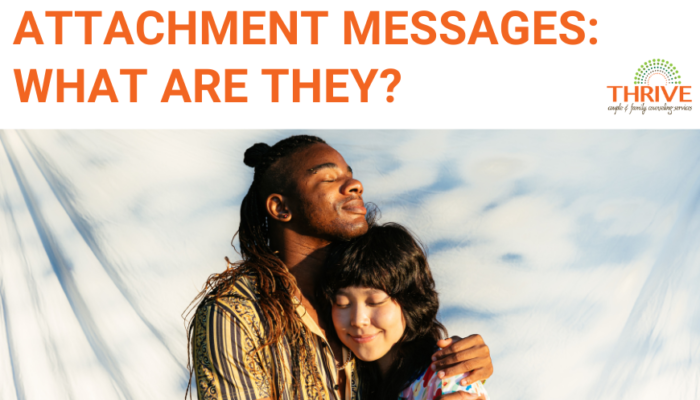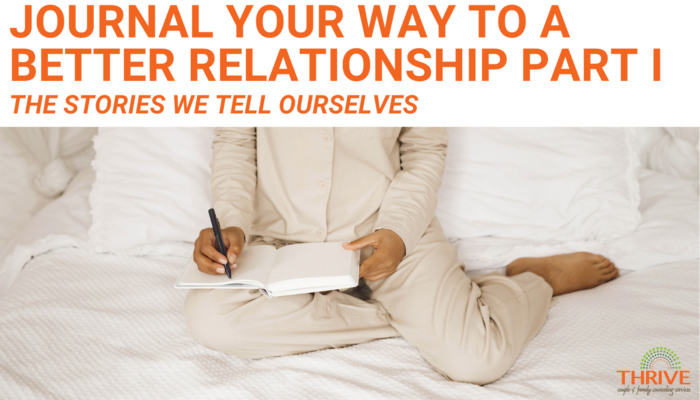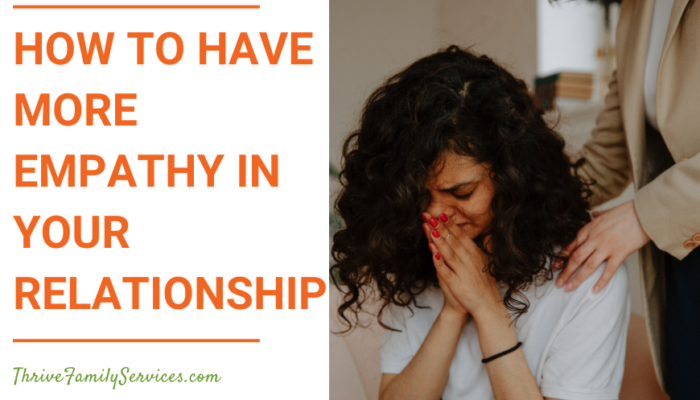As a relationship therapist, so much of my day is spent in front of couples. I’m there as they fight, cry, freeze, and risk vulnerability with each other. Regardless of the couple in front of me, one thing is glaringly obvious: Partners work so hard to feel a sense of safety, security, and connection with each other. All of them.
Even to people who aren’t therapists, this shouldn’t be surprising!
Why Do People Crave Attachment With Others?
From the time we are born, we need other people. Babies and infants rely on other people to get their physical, mental, and emotional needs met. As we grow to children, teenagers, and eventually adults, this doesn’t change. Having close relationships with other people is vital to so many aspects of our well-being! We are innately hard-wired to maintain a sense of connection and closeness with other people just as much as we’re hard-wired to need food, warmth, and safety.
In fact, research has shown that loneliness is a more dangerous health risk than smoking or high blood pressure. Furthermore, for people with congestive heart failure, the state of the patient’s marriage is one of the best predictors of survival and the patient’s degree of impairment. Distress in relationships impacts our immune system, our hormonal systems, and the longevity of our lives.
Dr. Sue Johnson, the creator of Emotionally-Focused Therapy says, “Love is not the icing on the cake for life. It is a basic primary need, like oxygen or water.”
Once we can understand that humans are inherently driven to connect and maintain connections with other people, it’s no surprise at all that our brains are constantly taking in information that tells us what to do with ourselves, our emotions, and our needs in order to keep our important relationships in a good, secure place.
Our interpretation of this information can be called “Attachment Messages.” Like the name implies, these messages are the things that we tell ourselves to do (or not do) to get or maintain feelings of security with the people we attach to.
It’s also no surprise that we all experience fear when our important relationships feel threatened with hardship, disconnection, or disagreements. Our attachment messages are meant to help us navigate these hardships to return the relationship to a place that feels less threatening.
What Exactly Are Attachment Messages?
Attachment messages are the roadmaps that we adapt as young children that tell us how to navigate connection. These messages carry us through our relationships into adulthood.
When we’re young (like really young) with developing brains, our brains are making sense of literally everything in the world, whether it’s safe or unsafe, whether we like it or don’t like it, and what our place in the world is. We are also making sense of what we do that brings people closer to us and what we do that feels like it threatens our security with the people we love.
The way our brains make sense of the world depends on a lot of things. Our biological make-up, the people that raise us, our birth order, our community and cultural messages, and traumatic experiences are just a few of the influences over our appraisal of the world.
The same thing could happen to two kids and they both might pull a different attachment message from that event.
How Do Attachment Messages Differ From Person to Person?
For example, Walter, who lives in Canada, and Sofia, who lives in Spain, do not get a lot of attention or affection from their parents. As they grow up, they have very different internal messages about what this meant for their sense of attachment security.
Walter adapted the message that he was a burden on his parents, so the attachment message he internalized was “minimize my needs and emotions so I don’t become more of a burden.” Being able to be good, not fuss, and undermine his own emotions seemed to keep him from feeling as burdensome to his parents.
On the other hand, Sofia adapted the message that her parents didn’t give her a lot of attention or affection because she didn’t matter. She noticed that she did get attention when she misbehaved, so she internalized an attachment message that told her “turn up the volume when I’m unhappy and then I’ll know I matter to my parents.” She felt more security when her parents yelled at her than when they ignored her because it made her feel more like she mattered.
Every kid in the world internalizes attachment messages like this.
They notice what makes their need for connection feel soothed and they notice what makes their need for connection feel threatened. Then they figure out what they need to do (or not do) in order to feel as close to secure as possible. After all, connection and love are human needs.
Where Do Attachment Messages Come From?
Attachment messages come from “Attachment Needs.” Attachment needs (sometimes called “attachment longings”) can simply be defined as the biological make-up of what humans need to feel in order to feel secure, connection, and closeness with the people that they love. As young people, we are constantly gauging if our attachment needs are being met. If we determine that they’re not being met, then we form an attachment message that tells us why that is and what to do about it.
What Are the Most Common Attachment Needs?
- To know I matter
- To know I am loveable
- To feel accepted
- To know I won’t be rejected
- To know I won’t be abandoned or isolated
- To know I am good enough
- To feel seen and heard
- To know I’m not a burden
It’s easy to see why feeling, knowing, and trusting that these things are true about you with your most important people would lead to a deep-rooted sense of security, safety, connection, emotional intimacy, and closeness.
How Do Attachment Needs Influence Attachment Messages?
We can use Walter and Sofia as examples again.
When Walter noticed that he didn’t get as much attention or affection as he needed from his parents, this left him with an unmet attachment need. Because of all of the parts that make Walter who he is, he determined that his attachment need of knowing that he is not a burden was unmet. This unmet attachment need led him to form the attachment message that his emotions and needs needed to go away to compensate for feeling like he was burdensome to his parents.
When Sofia noticed that she wasn’t getting as much attention or affection that she needed from her parents, she was also left with an unmet attachment need. Because of all of the parts that make up who Sofia is, her developing brain made the meaning that her attachment need of knowing she matters to her parents was unmet. This unmet attachment need led her to form the attachment message that if her parents responded to her, it meant she mattered in those moments. So she tried to get soothed as much as possible by doing anything she could to feel like she mattered in the moments she would get any kind of attention.
Because Walter’s behavior (getting quiet, being well-behaved) and Sofia’s behavior (getting loud, being disruptive) appear to be so different on the outside, it would be really hard to tell that they were suffering from the same unmet attachment need. It’s no wonder that so many well-intentioned parents and families have such a hard time understanding the meaning of their children’s behavior!
Does Everyone Have Attachment Messages and Attachment Needs?
It’s important to note that every single child has attachment needs and longings, and because parents are just people, it’s impossible that a child will always have every single attachment need and longing met all the time.
Similarly, even in the most secure relationships, there are going to be moments where one partner unintentionally left their other partner with an unmet attachment need or longing. This is guaranteed to happen whether it’s a parent & child relationship or an adult romantic relationship.
We all have attachment needs, we all go through moments of having unmet attachment needs, and we all have an internalized roadmap of attachment messages that tell us what to do to get that attachment need met again.
In secure relationships, children can turn to their parents and communicate their needs AND parents are responsive and attuned to their child’s attachment longings to soothe them. Maybe a third child, Frannie, turns to her mom with her arms outstretched and asks for a hug when she’s feeling like she isn’t getting enough affection, and Frannie’s mom scoops up her daughter into a big hug.
How Does a Secure Relationship Influence Attachment Messages + Needs?
Similarly, partners in a secure relationship can turn to each other in times of need to communicate their attachment longing and have it met. A secure relationship does not mean that partners always have their attachment needs met, and it does not mean that partners never feel hurt, scared, or lonely. This would be impossible!
A secure relationship just means that partners are able to repeat what Frannie and her mom can do. They can turn to each other and say, “I felt like I didn’t matter to you today when you were gone. Can we spend some time together now so we can reconnect?”
However, like Walter and Sofia demonstrated, sometimes our attachment messages (which determine our attachment styles) tell us that communicating needs directly and vulnerably is not an option. When our attachment needs aren’t met for a significant period of time, our attachment messages can lead to attachment fears.
What Are Attachment Fears?
“Attachment Fears” are the scary things that we can tell ourselves about ourselves, our partners, and our relationships. Attachment fears stem from attachment messages that go unsoothed. Attachment fears are directly tied to unmet attachment needs.
What Are the Most Common Attachment Fears?
Attachment fears that people commonly struggle with are:
- I do not matter
- I am not loved
- I will never be accepted
- I will be rejected
- I will be abandoned
- I am not enough
- I am not seen or heard
- I am a burden
These are some pretty scary things for people to tell themselves, especially knowing how crucial human connection and closeness is to everyone. It’s also no wonder how these attachment fears could influence a person’s behavior so that they feel like they can’t vulnerably turn to their partner in times of need to ask for repair.
Let’s go back to Walter, Sofia, and Frannie to explore these attachment fears.
Frannie
As Frannie goes up, she trusts more and more that whenever she has an unmet attachment need, she can turn to other people and tell them how she feels and what she needs. This creates a more positive interaction cycle for her because when she is clearly communicating how she feels and what she needs, other people have an easy time understanding what happened, how she feels, and what she needs.
This makes it easier for them to respond to her needs, repair them, and it keeps Sofia trusting that this is the best way for her to feel attachment security! Whenever someone is not able to repair her unmet attachment need, she knows it is not about her because her attachment fears have a very small presence.
Sofia
As Sofia grows up, her unmet attachment need eventually internalizes into the attachment fear that she does not matter. So, she does and says what she wants, regardless of how it impacts other people, because her attachment fear tells her that she does not matter to others. Eventually, Sofia meets Frannie and they start dating. Frannie is able to help Sofia more security that she does matter because Sofia is able to notice and respond to Sofia’s fears. Over time, Sofia is able to gain more trust that she can turn to Frannie and tell her how she’s feeling.
However, it’s still very scary to risk it because of her attachment fears. After all, when someone has told themselves for years that they don’t matter, being vulnerable would be terrifying! After repetitive successes with Frannie and doing couples therapy, Sofia is able to learn that she does matter to Frannie. This helps her feel less scared to turn to Frannie in her times of fear to ask for reassurance.
Walter
Walter, on the other hand, never got his attachment need met, so he forms the attachment fear that “I am a burden.” So he continues to dismiss, downplay, and avoid his own emotions and needs out of a fear of being more of a burden and pushing people away. Eventually, he gets married, and he still has an unmet attachment need that has left him with the fear of “I am a burden.” This need perpetuates his instinct to keep other people happy and to keep his own vulnerabilities to himself out of a fear of burdening other people.
We are all wired to form attachments to other people.
We figure out how to do this by gauging how well our attachment needs are being met. When we determine that we have an unmet attachment need, we have a script of attachment messages that tell us what to do to keep the attachment from being more threatened. Attachment fears form when those unmet attachment needs go unrepaired, and attachment fears ultimately block us from risking vulnerability as a way to try to keep the relationship from further damage.
How Do Attachment Messages, Attachment Needs, and Attachment Fears Keep Me Stuck in a Negative Cycle?
Like the example of Walter implies, Walter is so scared to risk having emotions and needs that he works very hard to keep them to himself to feel like he isn’t a burden in his family or in his marriage.
Attachment fears block people from turning to each other and asking for their unmet attachment need to be soothed in a vulnerable, clear way. When one or both partners in a relationship have attachment fears that keep them in a protective place, negative interaction cycles start to form.
For example, the more Walter downplays his emotions out of a fear of being a burden, the less his wife knows how he’s feeling. The less she knows how Walter is feeling, the more disconnected she feels from him. The more disconnected she feels from him, the more she verbalizes her unhappiness. The more that Walter is hearing that his wife is unhappy with him, the more intense his fear gets that he is burdening her. Then his attachment messages kick in and tell him to work harder at keeping his emotions down to risk being even more of a burden.
Sounds pretty stuck, right?
This is where Emotionally-Focused Therapy can help!
How Do I Stop Negative Cycles that Exist Because of My Need for Attachment?
In Emotionally-Focused Therapy (EFT), the therapist will work with you, you and your partner, or you and your family to identify the unmet attachment needs that fuel the negative cycle. Your therapist will also explore to see if there are any attachment fears that are preventing secure relationships from being formed. Once you and your therapist have identified the attachment messages at play, your therapist will help you have corrective experiences in session to help lessen the attachment fears and help your attachment needs feel met.
In the meantime, the next time that you start to feel distress in one of your important relationships, slow yourself down to see if you can pinpoint which attachment need felt like it wasn’t being met. Can you communicate that need to your important person in a clear, vulnerable way? Can your important person respond to your vulnerability securely, or do their own attachment fears get in the way?
Starting to identify the steps in your negative cycle and the good reasons you have for reacting in the way that you do is a great way to start creating change.


 Hello, I’m Emma Abel Loach.
Hello, I’m Emma Abel Loach.

